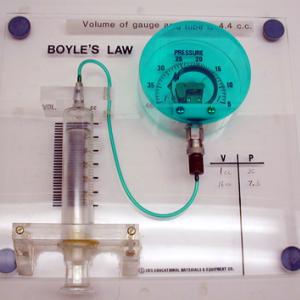College of Liberal Arts & Sciences
4E20.25 - Boyle's Law Demos - Overhead Model
Grease the syringe of the overhead unit as needed. Uncouple the connection between the syringe and gauge and move the plunger to the desired starting volume, remembering that the volume of the gauge and tube must be included. When this is done correctly a doubling of the volume will halve the pressure, and a halving of the volume will double the pressure.
- Athanasios Gkourmpis, "Discovering the Laws of Gases with a Manometer Based on Arduino", TPT, Vol. 61, #6, Sept. 2023, p. 500.
- Joel D. Krehbiel, Kenton N. Schroeder, Harune Suzuki, and Nelson Kilmer, "Using a Modified Boyle’s Law Experiment to Estimate the Density of Salts", TPT, Vol. 57, #1, Jan. 2019, p. 58.
- Richard P. McCall, "More on Systematic Error in a Boyle's Law Experiment", TPT, Vol. 50, #1, Jan. 2012, p. 22.
- Gavin D. Peckham, "P-V Diagrams Have More to Offer", TPT, Vol. 35, #1, Jan. 1997, p. 56.
- B.R.F Kendall, "Pumping Speed and Boyle's Law: Two Vacuum Experiments", TPT, Vol. 34, #9, Dec. 1996, p. 538.
- Changde Wei, "Improving the Syringe Method for Demonstrating Boyle's Law", TPT, Vol. 32, #7, Oct. 1994, p. 446.
- Volker Thomsen, "Solution on Third-Order Polynomials", TPT, Vol. 32, #1, Jan. 1994, p. 24.
- Robert W. Bird, "Got an Equation to Solve?", TPT, Vol. 32, #4, Apr. 1994, p. 199.
- N.Gauthier, "More Help for Thomsen?", TPT, Vol. 32, #4, Apr. 1994, p. 200.
- Tomas B. Greenslade, Jr., "The EME Boyle's Law and Absolute Zero Apparatus", TPT, Vol. 29, #2, Feb. 1991, p. 116.
- Malcolm Parry, "Circular Arguments and American Slugs", TPT, Vol. 29, #5, May 1991, p. 266.
- Michael D. Edmiston, "Boiling, Bubbles, and Pressure", TPT, Vol. 27, #3, Mar. 1989, p. 136.
- Thomas O. Callaway and Harry D. Downing, "Response", TPT, Vol. 27, #3, Mar. 1989, p. 136.
- G.T. Clayton, T. O. Callaway, and H. D. Downing, "Experiments with Disposable Hypodermic Syringes", TPT, Vol. 26, #1, Jan. 1988, p. 19.
- Larry Alofs and Edward B. McNeil, "'Boyle's Law Projected', TPT, Vol. 24, #2, Feb. 1986, p. 118." TPT, Vol. 24, #2, Feb. 1986, p. 61.
- Dileep V. Sathe, "A Boyle's Law Demonstrator", TPT, Vol. 22, #5, May 1984, p. 311.
- V. V. Raman, "The Gas Laws", TPT, Vol. 11, #7, Oct. 1973, p. 419.
- William Carlslon, "Boyle's Law Demonstration Using Vacuum Gauge", TPT, Vol. 5, #8, Nov. 1967, p. 387.
- R. K. Buchner, R. A. Doyle, "Apparatus to Demonstrate Boyle's Law", AJP, Vol. 44, #5, May 1976, p. 493.
- Marvin L. DeJong and Byron E. Leonard, "Demonstration of Boyle's Law on an Air Track", AJP, Vol. 40, #9, Sept. 1972, p. 1342.
- T. R. Girill, "The First Law of Elasticity", AJP, Vol. 40, #1, Jan. 1972, p. 16.
- Hg-1: Freier and Anderson, A Demonstration Handbook for Physics.
- Mary M. Atwater, "Boyle's Law with Syringes", The Science Teacher, May 1989.
Disclaimer: These demonstrations are provided only for illustrative use by persons affiliated with The University of Iowa and only under the direction of a trained instructor or physicist. The University of Iowa is not responsible for demonstrations performed by those using their own equipment or who choose to use this reference material for their own purpose. The demonstrations included here are within the public domain and can be found in materials contained in libraries, bookstores, and through electronic sources. Performing all or any portion of any of these demonstrations, with or without revisions not depicted here entails inherent risks. These risks include, without limitation, bodily injury (and possibly death), including risks to health that may be temporary or permanent and that may exacerbate a pre-existing medical condition; and property loss or damage. Anyone performing any part of these demonstrations, even with revisions, knowingly and voluntarily assumes all risks associated with them.

